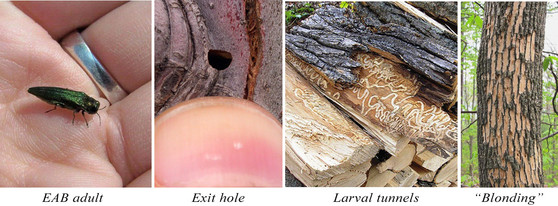
May 15 – 22, 2021
Maine celebrates Arbor Week and National Invasive Species Awareness Week.
Today, the Maine Department of Agriculture, Conservation and Forestry would like to talk about the ash tree, and its epic battle against the emerald ash borer.
Maine is home to three species of native ash trees, black (Fraxinus nigra), green (F. pennsylvanica), and white (F. americana), which make up approximately 4% of the hardwood trees in our forest. Each species has different traits that make the ash tree valuable in so many ways. White ash is very hard and strong; its wood used to make furniture, tool handles, oars, and even baseball bats. Green ash was one of the most widely planted ornamentals in North America due to its good form. Black, or brown, ash is a sacred tree that is part of the Wabanaki creation story. Its wood can be pounded to make strips suitable for basket-weaving, a centuries-long tradition of the region's indigenous tribes.
 |
Features of the ash tree; straight, tall with diamond-shaped furrows (left photo, Chris Evans, University of Illinois); opposite branching with compound leaves (photo by Keith Kanoti, Maine Forest Service); oar-shaped seeds (photo by Keith Kanoti, Maine Forest Service); wood strips from pounded black ash (photo by Lester Graham, Michigan Radio); black ash basket (photo by Abbe Museum); fall foliage of green ash (right photo by Steven Katovich, Bugwood.org)
Emerald Ash Borer (EAB)
In 2018, the invasive emerald ash borer (EAB) was found in Maine. EAB feeds primarily on ash trees, and can kill an ash tree in less than three years. EAB has been found in a number of towns in southern Maine in York, Cumberland, and Oxford counties, as well as in northern Maine in Aroostook county. Please help us find early infestations of EAB so that we can more easily manage EAB populations and protect more ash trees.
-
Learn how to spot ash trees. May is a great time to identify ash trees. While all the other hardwood trees have leafed out, Maine's ash trees are just starting. Look for opposite branching and small-ridged bark in a diamond-shaped pattern.
-
Learn clues that point to emerald ash borer presence. Now that you know what an ash tree looks like look for evidence of emerald ash borer in the trees. You may spot "blonding" on ash trees, the shallow flecking of the bark by woodpeckers going after EAB larvae and pupae. Or perhaps you will see S-shaped tunnels just under the bark. Please take photos and report your findings on the EAB Report Form.
-
Learn how to recognize emerald ash borer. Starting in June, look for EAB adult beetles as they start to emerge from ash trees. If you think you see an EAB, try to capture it or take a photo and report your findings on the EAB Report Form.
-
Volunteer to participate in the monitoring. Three ways to help monitor for emerald ash borer are:
-
Monitor ash for emerald ash borer damage and report signs or symptoms of attack (year round)
-
Monitor biosurveillance sites for emerald ash borer capture, taking advantage of an amazing natural system (Mid-July-August)
-
If you own or manage ash outside areas known to be infested, and have a tree to sacrifice to a good cause, participate in our girdled trap tree network (now and in the fall)
 |
Signs of emerald ash borer; the adult beetle, which emerges in June, is very small and bullet-shaped; exit holes are small and D-shaped; S-shaped tunnels made by larvae; woodpecker flecking (blonding).
To help your community find emerald ash borer infestations before they get so severe that they cannot be treated, we need your help!
During Emerald Ash Borer Awareness Week (May 23- 29th, 2021) everyone is encouraged to take a few minutes to learn about the signs and symptoms of emerald ash borer infestation on ash trees, so that the infestations can be better managed by local tree professionals and foresters.
The best way to slow the spread of emerald ash borer and other forest pests is avoid moving firewood long distances. Instead, buy local firewood, buy heat treated certified firewood, or gather firewood on site when permitted. Check out Firewood Scout for local sources of firewood in Maine.
Invasive Species Events During Maine Arbor Week and National Invasive Species Awareness Week, 2021
Check out Maine Arbor Week events presented by the Maine Audobon.
Spread awareness and celebrate the state's trees.
Take your National Invasive Species Awareness Week commitment beyond this week. Tell your friends, family, neighbors and others about invasive species! It's a big state, and we can't get the word out to everyone without your help. Encourage them to get involved with National Invasive Species Awareness Week in their own way. Here are some resources to help get started:
|